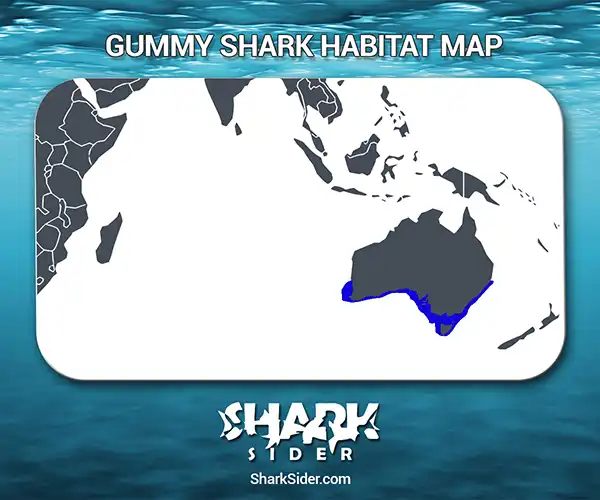Gummy sharks belong to the family of hound sharks, found in the temperate waters around certain parts of Australia. These sharks are in high demand for their meat, the “fish” in the delicacy “fish n’ chips”. They are also known as the Australian smooth hound, the Sweet William, or the smooth dog shark.
Gummy Shark Scientific Classification |
|
| Kingdom | Animalia |
| Phylum | Chordata |
| Class | Chondrichthyes |
| Order | Carcharhiniformes |
| Family | Triakidae |
| Genus | Mustelus |
| Scientific Name | M. antarcticus |
Description
Gummy sharks range from 18 to 69 inches and weigh around 67.9 lbs, with the females generally larger than the males. They are long and thin, with a flat, broad head and snout. Their teeth are plate-like and arranged in a pavement-like pattern, which gives the gummy shark its name.
Where do they live
Map Of The Gummy Shark’s Habitat

These sharks live in the eastern Indian Ocean, notably in southern Australia. Other places where the gummy shark lives include Western Australia through the Bass Strait to Tasmania and northern New South Wales, and on the coast of Japan. They stay in inshore and offshore waters, preferring the sandy bottom of the ocean floor. Younger sharks will form small colonies around southern Australia however, whether or not these are nurseries remains unknown.
Behavior
Hunting Gummy sharks feed on crustaceans, cephalopods, small fish, and worms. They hunt at night and use their teeth to crush their prey for easy consumption. Migratory The distance these sharks travel depends on their age and sex, with adults swimming longer distances than juveniles and females traveling further than their male counterparts. Reproductive They are ovoviviparous, giving live birth to 14- 57 pups after a gestation period of 11-12 months. The mating and ovulation period is about three months, generally from November to February. The newly borns usually have a ratio of 1:1 between males and females. Male gummy sharks become sexually mature at four years, while females are capable of reproducing at around six years of age. The average lifespan of a gummy shark is 16 years.
Adaptations
Like several other species of sharks, these sharks have counter-shaded coloring, i.e., their upperside is darkly colored to make it hard to spot them from above, while their underside is much lighter, making them more challenging to identify from below. This has led to the gummy shark having very few predators, with only the broadnose gill shark preying on juvenile specimens regularly.
Interactions with humans
The gummy shark is heavily sought after for its meat, marketed as “flake” in Australia. They are targeted heavily by anglers; however, there haven’t been any significant population drops, leading to the IUCN classifying them as “Least Concern” or “LC”. These sharks are not dangerous and are not known to bite humans. Instead, they flee if someone gets too close, making it hard to observe them in the wild.
